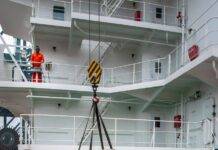
3 Leg Sling Calculation: Ensuring Safe and Efficient Lifting
3 Leg Sling Calculation : Lifting and moving heavy loads is a common task in various industries, such as construction, manufacturing, and logistics. To ensure the safety of both the workers and the materials being lifted, it’s essential to calculate the load capacity of the equipment used. This article explores the intricate world of 3-leg sling calculations, providing insights into why it’s crucial and how to perform these calculations accurately.
Introduction to Sling Calculations
Sling calculations are a fundamental aspect of material handling. They involve determining the maximum weight a sling can safely lift while considering various factors that affect its capacity. When it comes to 3-leg sling calculations, we’re dealing with a specific type of lifting equipment designed for complex and heavy loads.
The Importance of Accurate Sling Calculations
Accurate sling calculations are vital to prevent accidents, equipment damage, and potential injuries. Using a sling with a capacity below the actual load can lead to disastrous consequences, which is why it’s essential to ensure precision in these calculations.
Types of Slings
Before delving into 3-leg sling calculations, it’s important to understand the types of slings available. Common options include chain slings, wire rope slings, and synthetic slings. Each type has its unique characteristics and applications, making it important to choose the right sling for the job.
Calculating Load on a Three-Leg Sling
Three-leg slings are typically used when lifting irregularly shaped loads or when a more stable lifting configuration is required. To calculate the load on a three-leg sling, you need to consider the weight of the load, the angle of the slings, and the tension in each sling leg.
Sling Angle and Its Impact on Calculation
The angle between the slings plays a crucial role in determining the load’s effect on each leg of the sling. A smaller angle significantly increases the load on each leg, which must be accounted for in the calculations to ensure safe lifting operations.
Understanding Load and Tension
In 3-leg sling calculations, it’s vital to distinguish between the total load being lifted and the tension on each individual leg of the sling. The total load is the weight of the object, while the tension in each sling leg depends on the angle and load distribution.
Factors Affecting Sling Capacity
Sling capacity isn’t solely dependent on the sling itself. Other factors, such as the hitch type, the condition of the sling, and environmental conditions, can impact the sling’s capacity. These factors should be considered when performing calculations.
Safety Considerations in Sling Calculations
Safety is paramount when it comes to sling calculations. Always adhere to safety guidelines and regulations, including using certified slings, inspecting equipment regularly, and ensuring all personnel involved are adequately trained.
Step-by-Step Guide to Three-Leg Sling Calculation
Performing three-leg sling calculations involves a systematic process. Here’s a step-by-step guide to help you navigate through the calculations and ensure accurate results.
- Determine the weight of the load.
- Understand the sling angle.
- Calculate the tension in each sling leg.
- Calculate the resultant load on each sling leg.
- Verify that the sling’s capacity exceeds the calculated load.
Common Mistakes to Avoid
Mistakes in sling calculations can be costly. Some common errors to avoid include neglecting sling angles, underestimating the load, and using damaged or uncertified slings.
Tips for Ensuring Accurate Sling Calculations
To improve the accuracy of sling calculations, consider these tips:
- Regular equipment inspections
- Employee training and certification
- Proper documentation of calculations
- Consulting with experts when dealing with unusual loads
Importance of Training and Certification
Training and certification for personnel involved in sling operations are essential for ensuring safe and efficient lifting. Certified individuals have the knowledge and skills to perform accurate sling calculations and handle equipment properly.
Here's a sample scenario illustrating a 3-leg sling calculation:Scenario: Lifting a Heavy Industrial Machine
Imagine you’re working in a manufacturing facility, and your team needs to move a heavy industrial machine weighing 5,000 kilograms. This machine has an irregular shape, making it challenging to lift with conventional equipment. To ensure stability and even distribution of the load, you decide to use a 3-leg sling for the lifting operation.
Step 1: Determine the Weight of the Load
The first step in any sling calculation is to determine the weight of the load you’ll be lifting. In this scenario, the industrial machine weighs 5,000 kilograms.
Step 2: Understand the Sling Angle
Before proceeding, you need to assess the angle at which the slings will be attached to the load. In this scenario, the slings are attached at a 60-degree angle to the horizontal.
Step 3: Calculate the Tension in Each Sling Leg
To calculate the tension in each sling leg, you can use the following formula:
Tension = (Total Load / Number of Legs) / (2 * sin(1/2 * Sling Angle))
In our scenario, the calculation would be as follows:
Tension = (5,000 kg / 3) / (2 * sin(1/2 * 60°))
This yields a tension of approximately 1,666.67 kg in each sling leg.
Step 4: Calculate the Resultant Load on Each Sling Leg
Since the slings are at a 60-degree angle, the tension in each leg is equal. Therefore, the resultant load on each sling leg is also 1,666.67 kg.
Step 5: Verify Sling Capacity
Before proceeding with the lift, it’s essential to check the capacity of your 3-leg sling. It should always exceed the calculated resultant load. For instance, if the sling’s capacity is 2,000 kg, you can proceed with the lift safely.
This calculation ensures that the 3-leg sling can safely lift the heavy industrial machine while maintaining balance and avoiding overloading. By following these steps and considering the sling angle, you can conduct a safe and efficient lifting operation in your manufacturing facility.
Conclusion
Accurate 3-leg sling calculations are crucial for safe and efficient material handling. Understanding the load, sling angles, and tension in each leg of the sling is vital for preventing accidents and equipment damage. By following safety guidelines, conducting regular inspections, and providing proper training, industries can ensure a secure lifting environment.
Web Sling Size and Capacity with Chart
Web Belt Sling Working Load Limit (WLL)
FAQs – Frequently Asked Questions
- What is the significance of sling angle in calculations?Sling angle affects the load distribution on each sling leg. A smaller angle increases the load on each leg, so it’s vital to consider it in calculations.
- How often should I inspect my slings?Regular sling inspections are essential, and the frequency depends on factors such as sling type and usage. Follow manufacturer recommendations and industry standards.
- Can I use damaged slings for lifting?No, using damaged slings is extremely unsafe and should be avoided. Always inspect your slings and replace damaged ones immediately.
- Are there any specific regulations for sling calculations?Yes, there are industry-specific regulations and guidelines for sling calculations. Make sure to follow the regulations applicable to your industry.
- Why is training and certification important for personnel involved in sling operations?Training and certification ensure that personnel have the necessary knowledge and skills to perform accurate sling calculations and operate equipment safely, reducing the risk of accidents.
























